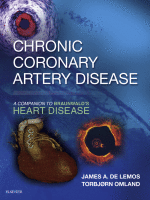Physical Address
304 North Cardinal St.
Dorchester Center, MA 02124

Introduction Great strides have been made in reducing morbidity and mortality from heart disease in recent decades. Despite this, coronary artery disease (CAD) rates remain unacceptably high. CAD is the single largest cause of mortality in the United States and…

Introduction Despite a 31% decline in the death rate from atherosclerotic cardiovascular disease (ASCVD) (i.e., coronary heart disease [CHD] or stroke) between 2001 and 2011, ASCVD remains the cause of approximately one of three deaths in the United States. More…

The atherosclerotic process begins in childhood and manifests clinically in adulthood as an acute atherothrombotic event (acute coronary syndrome or stroke) or as symptomatic obstructive disease (angina or claudication) ( Fig. 28.1 ). The major risk factors for atherosclerotic cardiovascular…

Introduction Angina is first and foremost a pain signal that originates from the heart to reach the brain. Typically, angina is triggered by myocardial ischemia. In addition to advanced coronary artery disease (CAD), microvascular dysfunction and vasospastic angina are well-described…

Introduction Many patients with chronic coronary heart disease (CHD) have clinically significant depression: a costly, disease-accelerating comorbidity that is associated with compromised health-related quality of life and reduced quality-adjusted life years (QALYs). Depression is also associated with an increased risk…

Introduction Treatment of angina and evidence of myocardial ischemia on stress testing with no obstructive coronary artery disease (CAD) by angiography is a challenge. Previously referred to as cardiac syndrome X, this syndrome was believed to have a benign cardiovascular…

Introduction Patients with diabetes mellitus—both type 1 and type 2—exhibit an increased risk of developing cardiovascular disease (CVD) with its sequelae of myocardial infarction, stroke, and heart failure. Compared to patients without diabetes, the management of coronary artery disease (CAD)…

Introduction The indications for coronary revascularization among patients with chronic coronary heart disease evolve as the scientific information accumulates and technology advances. The benefits associated with prompt coronary revascularization in reducing cardiovascular death and nonfatal myocardial infarction (MI) in patients…

Introduction The relationship between coronary heart disease (CHD) and sudden cardiac death (SCD) has long been recognized, with an initial description by Leonardo Da Vinci in the 15th century of an SCD, which he witnessed and attributed at autopsy to…

Introduction Chronic coronary artery disease (CAD) is a heterogeneous condition that encompasses patients with a history of acute coronary syndrome (ACS), patients with a history of coronary revascularization by percutaneous coronary intervention (PCI) or surgery, patients with stable angina symptoms,…